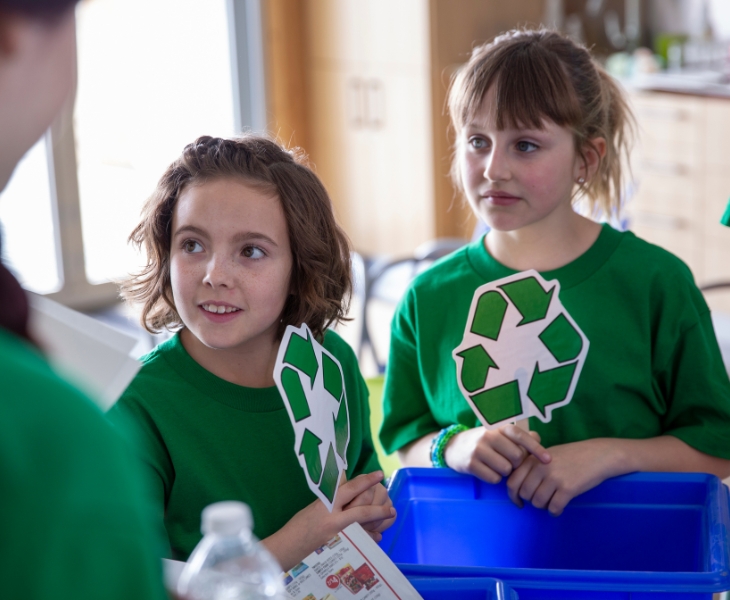Sustainable Schools: Fighting for Future Generations
Becoming a more sustainable school is a crucial step towards creating a better future for both the environment and future generations. Sustainability in schools involves reducing waste and energy consumption, promoting eco-friendly practices, and teaching students about the importance of taking care of the planet. Across Australia, teachers and staff across Australia are increasing their efforts to implement sustainability practises, which not only benefit the environment but also help schools save money, improve student health and well-being, and foster an environment of environmental responsibility.
One of the most cost-efficient ways to start is to recycle. The more we recycle, the more energy we save, and the more waste we save from going into landfill. By taking small steps, schools can become more sustainable and set a positive example for future generations.
1. Reduce Paper Consumption
The most effective way to reduce waste, particularly in a sustainable school is to reduce paper consumption. The challenge is that in schools there are still many tasks that just can’t go paperless. One way to be more sustainable when it comes to paper in the workplace is to find ways of reusing it before it makes it’s way into the paper recycling bin.
- Used, or misprinted documents are great for use as art or note paper
- Double sided printing is a great paper saver, and perfectly acceptable for internal documents and notes sent home to parents
- Shredded paper can be donated to your local animal shelter for use as bedding – what a great initiative for students!
2. Save on Packaging
Boxes and packaging are a huge source of waste, and while choosing eco-friendly options is a great start to becoming a sustainable school, there are other steps which can be taken to reduce and reuse.
- Use shredded paper or reclaimed packing materials for packaging, or arts and crafts projects
- Find ways to reuse delivery boxes. They make great storage for the classroom!
- Consider ordering in bulk to reduce packaging waste
3. Find Out What’s Recyclable
Paper and cardboard aren’t the only recyclable items. You’d be surprised at what can be recycled through various companies and government initiatives. Your sustainable school can also subscribe to Terracycle Waste Boxes for typically hard-to-recycle waste streams to reduce your landfill waste.
- Ink and toner cartridges can be easily recycled, and many companies organise their own pick up of used cartridges
- Most plastics can now be recycled through regular council recycling or soft-plastics programs
- Old computers and mobiles can be wiped of memory and sent to companies who specialise in reusing their parts
- Paint, batteries, coffee pods, and aerosol cans can all be recycled through specific organisations
4. Energy-saving Measures
Energy consumption accounts for a significant portion of a school’s carbon footprint. Implementing energy-saving measures is a critical step towards making a sustainable school.
- Upgrade to energy-efficient fluorescent or LED lightbulbs
- Installing low-flow toilets, showerheads, and faucets
- Use motion-sensor lights in unoccupied rooms, which automatically turn on or off in response to movement
- Where possible, use fans and open windows instead of air conditioning
- Turn off computers and monitors when not in use
5. Small Changes for Big Environmental Impact
If many of us make a few small changes to our daily lives we can accomplish a lot, together.
- Encourage your students to use reusable water bottles and lunch containers, and staff to use reusable coffee cups
- Install a water filter for easy, and clean refilling
- Schools can also encourage composting to reduce food waste and reduce the amount of waste sent to landfills.
- Provide options for eco-friendly products
- Encouraging active transportation, such as walking, biking, or using public transportation to reduce carbon emissions
6. Invest in Good Bins and Labelling
Most schools use a lot of recyclable materials, so make it easy for everyone to dispose of things properly by providing separate waste bins for each recycling option. Include a visible label that provides practical guidelines to help encourage a sustainable school and promote recycling.
You can also provide colour-coded bins to accommodate each recycling facility.
7. Educate Employees
For any recycling initiative to be successful, everyone needs to be on-board and motivated. Engage with teachers, staff, and students to ensure they are aware of the right way to recycle and what options are available, while also making it simple for them to contribute.
You may need to implement an ongoing program to remind everyone what can and can’t be recycled. There’s no reason education can’t be fun too, and it’s really worth putting in the effort so that everyone is as enthusiastic as they are educated.
- Create competitions for the least amount of waste produced
- Devise a sustainable schools program which is engaging and informative
- Introduce rewards for achieving recycling goals
8. Communicate
You can run a recycling awareness day to help boost the adoption rates of the recycling program. Provide engaging infographics and activities for inspiration and provide a greater understanding of the recycling program and help kickstart a more sustainable school.
The day can also be used to educate teachers, staff and students on the impact recycling has on the environment and the costs associated with waste production.
- Hold games and activities which reinforce the message of recycling
- Take an excursion to a local waste management depot
- Invite an expert to present on issues related to recycling
9. Eco-Friendly Cleaning Products
Introducing a recycling program in your sustainable school doesn’t have to be complicated. A few simple changes, introduced over time, can really change people’s views on waste management. Boost everyone’s involvement in recycling and help to make a difference to the planet.

